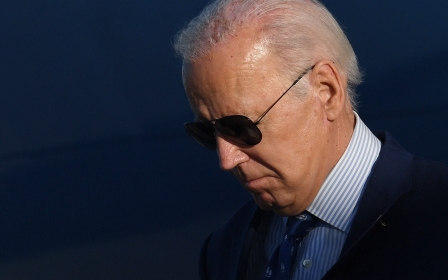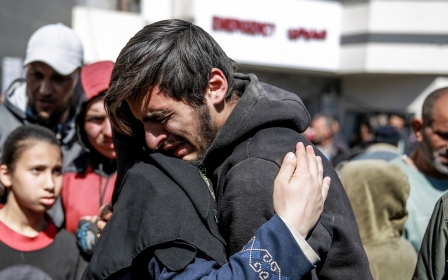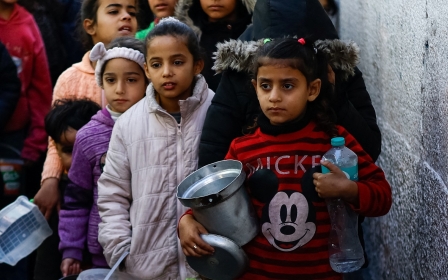War on Gaza: Why US humanitarian aid plan is a sham

US President Joe Biden is getting hammered in the Democratic primaries. Though he has no opposition, nearly 400,000 primary voters across multiple states have abandoned him, choosing “uncommitted” instead.
The protest movement began in the critical swing state of Michigan, where more than 100,000 voters made a statement against Biden’s support for Israel’s war on Gaza. In subsequent primaries, hundreds of thousands more followed suit; in Minnesota alone, 20 percent of voters said they were uncommitted.
Many Democrats disapprove of this war and the president who is supporting it. Countrywide, 57 percent of Americans are unhappy with Biden’s handling of the Israel-Palestine conflict, and 67 percent want a permanent ceasefire in Gaza.
Fifty-two percent say the US should halt arms shipments to Israel until current hostilities cease; among those who voted for Biden in 2020, that number increases to 62 percent. Even a majority of American Jews (50 percent) favour a permanent ceasefire, according to recent polling.
Biden is already paying the price for being out of sync with the Democratic base. He has to do something, and fast - otherwise, this could snowball into an avalanche. This is how movements begin and sure-fire candidacies fall apart.
New MEE newsletter: Jerusalem Dispatch
Sign up to get the latest insights and analysis on Israel-Palestine, alongside Turkey Unpacked and other MEE newsletters
Daily assurances from the president and senior officials that the US is doing everything in its power to minimise civilian casualties are no longer credible. Biden’s vow to hold a “come to Jesus” meeting with Israeli Prime Minister Benjamin Netanyahu rings hollow. Reports that Biden is increasingly exasperated with Netanyahu seem more like theatrics than substance.
Biden has tools at his disposal to bring Israel to heel, such as cutting off billions of dollars in weapons exports. He could demand an immediate, permanent ceasefire and support UN Security Council resolutions to that effect. But he refuses to do so, while also bragging: “I don’t believe you have to be a Jew to be a Zionist, and I am a Zionist.”
To counteract voter malaise, the president recently rolled out yet another band aid masquerading as a cure for cancer. During his State of the Union speech last week, Biden announced an “emergency mission” to build a pier on the Gaza coast that would “enable a massive increase in the amount of humanitarian assistance getting into Gaza every day”. Democrats in the audience rose to their feet and cheered as if this was a miraculous solution to world hunger.
Ineffective measure
During his speech, Biden welcomed families of Israeli hostages in the visitor’s gallery. But glaringly absent were any families from Gaza whose loved ones have died or suffered under siege and bombardment for more than five months.
In his speech, Biden said the US “has been leading international efforts to get humanitarian assistance into Gaza”. After Israel opened fire on an aid convoy in Gaza City late last month, the US began air-dropping aid packages into the besieged territory, but many observers have decried this measure as ineffective. A single air drop produced 38,000 individual meals, a pittance for more than two million people who are going hungry.
Follow Middle East Eye's live coverage of the Israel-Palestine war
The main aid bottleneck is the Israeli army, which routinely refuses to permit the entry of trucks queueing on the Egyptian side of the Rafah crossing. Israel is using starvation as a weapon of war, exacting vengeance on the entire population of Gaza. This also serves as a useful political tool for Israel’s far-right government: polls show that two-thirds of Israelis support the denial of food to Gaza.
Those who fled the north are now starving in the south. If they are to starve, they would prefer doing so in their own homes, rather than in makeshift tent camps
Biden’s maritime corridor plan will not circumvent Israeli obstacles, with the White House noting that the Israelis “have worked very closely with the Cypriots now for months to establish the mechanism in Larnaca port that will be essential”. Israeli officials will inspect the cargo in the Cypriot port before it is shipped to Gaza.
In Gaza, the cargo will be offloaded to a pier constructed by the US Army. It will then be handed off to humanitarian agencies for distribution to starving Palestinians. But the Israeli army, which controls the Gaza shoreline, could again interfere at this juncture.
When a journalist asked a Pentagon official how the US could guarantee that Israel would not sabotage the aid plan, he replied: “Our focus is on delivering the aid. I’m not going to speak for the Israelis.” Not the most reassuring response.
Daily distribution via the sea route would reportedly max out at around 200 truckloads of aid, less than half the amount necessary; before the war, Gaza’s population received around 500 truckloads a day. While dozens more truckloads of aid can be expected via Jordan and Egypt, the total will still fall short of Gaza’s aid requirements.
Delay tactic
The US plan has been roundly criticised as insufficient, with Melanie Ward, the head of Medical Aid for Palestinians, telling Al Jazeera: “Air drops, temporary seaports and the like are not realistic or lasting solutions to stave off looming famine and sustain life in Gaza … Only an immediate and lasting ceasefire will allow us to deliver the massive humanitarian response that is required.”
Biden has promised an imminent ceasefire for weeks, with none in sight. Lately, both Israel and the US have blamed Hamas, saying the framework for a deal is in place, while the Palestinian group is the sole impediment. Hamas seeks a permanent ceasefire, the withdrawal of Israeli troops, and the return of displaced Palestinians to northern Gaza.
The US has repeatedly said that displaced people “must be allowed to return to homes in the north as soon as possible”, but Israel has refused to permit this. The White House last week justified a postponement in their return, saying: “To get people to the north … you have to have reliable humanitarian assistance in the north.”
That puts the cart before the horse. Those who fled the north are now starving in the south. If they are to starve, they would prefer doing so in their own homes, rather than in makeshift tent camps.
In addition, the decision to return should not be made by the US. It should be in the hands of displaced Palestinians themselves. The US condition is a delay tactic, allowing the administration to say it supports their return, but not just yet. These are empty promises.
Meanwhile, administration officials continue to shift the focus onto Hamas, telling reporters that the group’s leader “has called for violence over Ramadan, so we recognise that this is something that they might very well try to do. And it’s always a volatile period.” And yet, Israel is inciting violence by permitting settlers to enter al-Aqsa Mosque complex and pray for its destruction and the building of a Third Temple, while Israeli police beat Palestinian worshippers.
Biden has failed at every step during this war to realise his stated objectives of obtaining a ceasefire and providing humanitarian aid to Gaza. American voters will hold him accountable on election day.
The views expressed in this article belong to the author and do not necessarily reflect the editorial policy of Middle East Eye.
Middle East Eye delivers independent and unrivalled coverage and analysis of the Middle East, North Africa and beyond. To learn more about republishing this content and the associated fees, please fill out this form. More about MEE can be found here.






